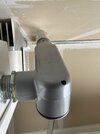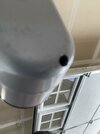I haven't been around much lately, all these code changes giving me headaches. Lots of confusion on the AHJ sides, which hopefully will lessen over the next few weeks as AHJ get trained.
We finally have the UL9540A Fire test report and are waiting for jurisdictions to accept it, so we can go back to stacking as soon as they do.
I can't give out details of the fire test, but it's pretty safe to say that barring significant physical damage, a Tesla Powerwall is not going to propagate a fire if it fails. You have to send multiple adjacent cells (more than 3) into thermal runaway at once, and multiple simultaneous failures like that are pretty unlikely, barring someone shooting the thing or other massive physical damage.
As to the point, if the ESS unit were to be on fire, it's usually pretty easy to hit the button with a long stick, broom or whatever is available.
Water ingress issues are like
@wwhitney mentions are usually mitigated by the way the conduit routing is designed. All conduit penetrations to the interior space need to be sealed with Duct Seal, sometimes weep holes need to be added to an LB or a Junction box. I agree with other responders that this issue should be addressed.




